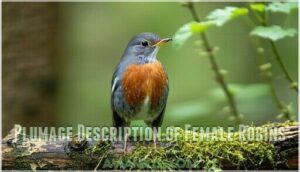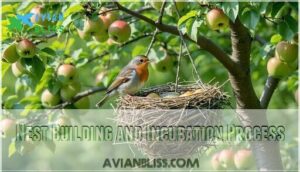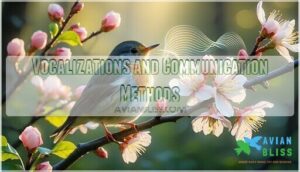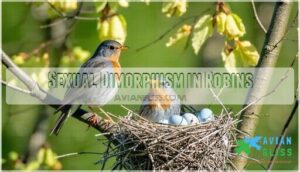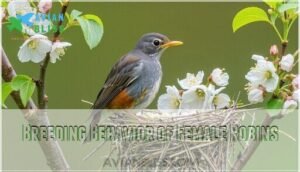This site is supported by our readers. We may earn a commission, at no cost to you, if you purchase through links.

Female robins are the master architects of their species, building sturdy cup-shaped nests using mud, grass, and twigs. During breeding season, you’ll spot them foraging quietly on lawns, hopping with that characteristic robin gait while hunting for earthworms and insects.
Their muted plumage serves a vital purpose—keeping them hidden while incubating eggs and protecting vulnerable chicks from predators. This behavior is crucial for the survival of their offspring, and the female robin’s ability to remain hidden is a key factor in their success.
Table Of Contents
- Key Takeaways
- Physical Characteristics of Female Robins
- Behavioral Traits and Nesting Habits
- Plumage Description of Female Robins
- Territorial Behavior and Migration Patterns
- Nest Building and Incubation Process
- Vocalizations and Communication Methods
- Sexual Dimorphism in Robins
- Breeding Behavior of Female Robins
- Identification of Female Robins
- Frequently Asked Questions (FAQs)
- What does a female robin look like?
- What is the difference between a male and female Robin?
- Are American robins male or female?
- What is a female American robin called?
- How do you know if a Robin is male or female?
- How big do female Robins get?
- What is the color of a female robin?
- Do female robins look different?
- How do you tell a male robin from a female?
- What color is a female robin?
- Conclusion
Key Takeaways
- You’ll easily identify female robins by their muted coloring – look for pale orange breasts instead of the male’s bright red, plus grayish-brown backs that provide perfect camouflage while nesting.
- Female robins are master nest builders who handle all construction duties – they craft sturdy cup-shaped nests using mud, grass, and twigs, then incubate 3-5 blue eggs for 12-14 days with minimal breaks.
- Their subdued plumage serves a crucial survival purpose – the duller colors keep them hidden from predators while they’re vulnerable during egg incubation and chick-rearing periods.
- You can distinguish females through behavior as well as appearance – they’re typically smaller than males, forage quietly on lawns, and focus on nest defense rather than the territorial singing that males are known for.
Physical Characteristics of Female Robins
Female robins showcase distinct physical traits through sexual dimorphism.
You’ll notice their muted colors – paler orange-red breast feathers compared to males’ vibrant plumage.
Female size averages slightly smaller at 2.5-2.7 ounces versus males’ 3+ ounces.
Their head shape features a V-shaped peak, contrasting males’ U-shaped profile.
Eye-ring vibrancy appears less bright, with duller bill color completing their understated appearance.
Body proportions and head shape are key identifiers when observing female robins, but also consider plumage and coloration for accurate identification using physical characteristics and observing distinct traits.
Behavioral Traits and Nesting Habits
When you observe female robins during breeding season, you’ll notice their nest building expertise takes center stage. These dedicated mothers choose secure locations 5-25 feet high, constructing sturdy cup-shaped homes using mud, grass, and plant fibers.
Female robins are nature’s master architects, crafting secure sanctuaries with unwavering maternal dedication.
Their nest is reinforced using mud from castings to create a sturdy foundation.
Incubation becomes their primary focus for 12-15 days, rarely leaving eggs unattended for more than 30 minutes. Courtship feeding from males helps females gain weight for egg production.
Their foraging behavior shifts to quick, efficient trips while maintaining vigilant predator avoidance near the nest. Female aggression emerges when defending territory, and social interactions decrease during nesting periods before winter roosting begins.
Plumage Description of Female Robins
When you spot a female robin, you’ll notice her more subdued beauty compared to her flashy male counterpart.
Female Colors appear as duller orange-red breasts with brownish-grey backs, while Plumage Variation includes scattered grey and brown flecks across white underparts.
Seasonal Changes bring molting in late summer and worn feathers during breeding season.
Spectrometry Analysis confirms these feather color differences serve a Camouflage Purpose, helping females blend into leafy backgrounds while nesting.
Like their male counterparts, they also use magnetic fields for navigation.
- The soft reddish-orange breast that whispers warmth instead of shouting for attention
- Charcoal-toned wings that dance between shadow and light
- Earth-toned back feathers that embrace the forest floor
- Pale eye-rings that frame gentle, watchful eyes
- Mottled underparts that tell stories of survival and motherhood
Territorial Behavior and Migration Patterns
Territorial dynamics reveal fascinating differences between male and female robins.
While males fiercely defend fixed breeding territories through aggressive displays and combat, females demonstrate more flexible territorial behavior.
During breeding season, females defend smaller territories ranging 0.1-0.3 hectares, using wing-flicking and alarm calls rather than physical confrontation.
Migration patterns also differ—females depart wintering grounds 3-10 days after males, traveling 1,000-2,500 kilometers to northern breeding sites.
Their territorial behavior adapts seasonally, becoming less defined post-breeding when they join mixed flock dynamics for foraging.
Many birds use visual landmarks as road signs during these journeys.
Nest Building and Incubation Process
Architecture meets instinct when female robins begin their remarkable nest-building journey. You’ll witness these skilled craftswomen create secure homes through painstaking construction and unwavering dedication to their clutch.
Nature’s master builders work with precision that rivals human architects, shaping tomorrow’s generation one twig at a time.
- Nest Materials Collection: Female robins gather approximately 350 twigs plus grass, moss, and mud, requiring 25 grams of mud for the inner cup’s structural integrity.
- Nestbuilding Timeline: Construction takes 5-7 days, with females molding the 10-15 cm diameter nest using their breast and feet for precise cup shaping.
- Egg Incubation Period: Clutches of 3-5 robin eggs receive 96% daytime attention, with females maintaining 36-38°C nest temperatures during the 12-14 day incubation timeline.
- Nest Defense Strategy: Protective mothers fiercely guard their bird nesting sites, ensuring 80% survival rates through vigilant fledgling care and territorial behavior. Understanding these behaviors is essential, as birds may exhibit dive bombing tactics to protect their nests.
Vocalizations and Communication Methods
Female robins communicate through distinct vocalizations that differ from their male counterparts.
You’ll hear their signature "whisper songs" during breeding season—soft, brief melodies used for mate communication and territory maintenance.
Unlike males’ boisterous performances, female calls are subtle yet purposeful.
They produce sharp "tic" alarm signals when threats approach their nests, alerting both mates and offspring to danger.
Their vocal learning adapts to environmental pressures.
Song complexity increases in dense populations, while cooperative communication strengthens during parental care.
| Vocalization Type | Purpose |
|---|---|
| Whisper Songs | Mate communication, territory marking |
| Alarm Signals | Predator warnings, nest protection |
| Contact Calls | Maintaining pair bonds |
| Foraging Calls | Coordinating with mate |
| Fledgling Guidance | Directing young birds |
These robin bird vocalizations operate within a 2.5-5.5 kHz frequency range, perfectly designed for concealment from predators while maintaining effective bird communication.
Robins also use non-vocal communication techniques such as visual cues to convey messages.
Sexual Dimorphism in Robins
Understanding sexual dimorphism in robins helps you distinguish between males and females at first glance. Plumage differences represent the most noticeable variation between sexes. Males display vibrant, deep rusty-red breasts that practically glow in sunlight, while females sport more muted reddish-orange coloring that blends seamlessly with their surroundings.
Size variations between male vs female birds are subtle but present. Males typically measure slightly larger, weighing up to 3+ ounces compared to females at 2.5-2.7 ounces. However, don’t rely solely on size—females carrying eggs can appear bulkier than males.
Behavioral dimorphism becomes obvious during breeding season. Males sing complex melodies from prominent perches, defending territory with fierce determination. Females focus on nest construction and rarely vocalize beyond simple calls.
The genetic basis for these differences stems from sex chromosomes, while their evolutionary significance lies in reproductive success. Males’ bright plumage differences attract mates, while females’ subdued colors provide camouflage protection during vulnerable nesting periods. These behavioral patterns guarantee species survival through specialized roles. Females also require significant calcium intake during nest construction and egg production.
Breeding Behavior of Female Robins
Spring awakens a remarkable transformation in female robins as they shift into full breeding mode. During this critical period, female mate selection becomes a careful process where they evaluate potential partners based on song quality and territory resources. Once paired, these dedicated mothers undertake an impressive reproductive journey.
The breeding season reveals three key behaviors that showcase their remarkable dedication:
- Nest construction mastery – Females single-handedly build sturdy nests in 2-6 days, shaping each cup with their bodies
- Precise egg laying process – They lay 3-5 beautiful blue eggs over consecutive days, timing each perfectly
- Intensive parental care roles – Mothers incubate eggs for 12-14 days, leaving only briefly for food
During incubation, you’ll notice females maintaining constant vigilance while keeping eggs at exactly 37-38°C. Some species exhibit promiscuity to enhance diversity within their offspring. Their chick rearing success depends on feeding nestlings every 15-20 minutes with protein-rich insects and worms. Post-fledging behavior continues for two additional weeks as mothers guide their offspring toward independence, demonstrating nature’s most devoted parenting.
Identification of Female Robins
Spotting female American Robins requires a keen eye for subtle differences. You’ll notice their Female Plumage appears more muted than males, with a lighter reddish-orange breast instead of the deep rusty red. Their wings show a charcoal tone rather than stark black, and the Head Shape often displays a more V-shaped peak compared to males’ squarer appearance.
Don’t rely on Size Overlap alone—females can actually weigh more when carrying eggs. Instead, watch for Behavior Clues. During nesting season, you’re likely to spot females constructing nests or sitting quietly on eggs while males sing boldly from nearby perches.
Their songs are territorial signals during this time.
Seasonal Variation affects identification too. Female plumage may fade by late summer due to breeding wear. Whether you’re observing European Robin or American Robin species, remember that bird gender identification improves with practice.
The key to successful male vs female identification lies in combining physical traits with behavioral observations rather than relying on single characteristics.
Frequently Asked Questions (FAQs)
What does a female robin look like?
You’ll recognize her by the muted, pale orange breast that’s less vibrant than males’.
She displays grayish-brown wings, a lighter gray head, and cream-colored belly that helps camouflage her during nesting.
What is the difference between a male and female Robin?
While birders squint through binoculars debating gender differences, you’ll notice males sport darker black heads and brighter rusty-red breasts.
While females display muted gray-brown heads with paler orange-red chests for camouflage protection.
Are American robins male or female?
American robins include both males and females – they’re not exclusively one gender.
You’ll find both sexes in robin populations, with males displaying brighter orange-red breasts and darker heads, while females show more muted coloring for camouflage protection.
What is a female American robin called?
Like Shakespeare’s "What’s in a name?" you’ll find there’s no special term for female American robins.
They’re simply called "female robins" or "hen robins," just as males are "male robins" or "cock robins.
How do you know if a Robin is male or female?
You’ll spot male robins by their darker black heads and brighter rusty-red breasts, while females display lighter gray-brown heads and paler orange breasts for better camouflage during nesting.
How big do female Robins get?
Female robins reach 5-5 inches in length with a 12-16 inch wingspan, weighing 5-7 ounces. They’re slightly smaller than males but can weigh more when carrying eggs during breeding season.
What is the color of a female robin?
You’ll notice female robins have grayish-brown heads, medium brown backs, and pale orange-brown breasts that’re lighter than males’. Their bellies are light beige with yellow-orange beaks.
Do female robins look different?
Yes, you’ll notice female robins have distinctly different appearances from males.
They’re smaller with muted, paler coloring – dustier gray wings, lighter orange breasts, and less contrast between their head and back feathers, which includes dusty and paler coloring.
How do you tell a male robin from a female?
Wonder how to spot the difference between robin genders? Look for the male’s deeper rusty-red breast and darker head versus the female’s lighter orange-red breast and muted gray coloring.
What color is a female robin?
You’ll spot a female robin by her grayish-brown head, medium brown back, and pale orange-brown breast that’s more muted than males’ vibrant rusty-red coloring.
Conclusion
Spotting a female robin becomes second nature once you know what to look for.
You’ve learned that her muted orange breast, grayish-brown back, and smaller size distinguish her from males.
Her exceptional nest-building skills and quiet foraging behavior make her fascinating to observe.
Remember, that subtle coloring isn’t a weakness—it’s her superpower for protecting the next generation of robins in your backyard, utilizing her quiet foraging behavior and exceptional nest-building skills.

